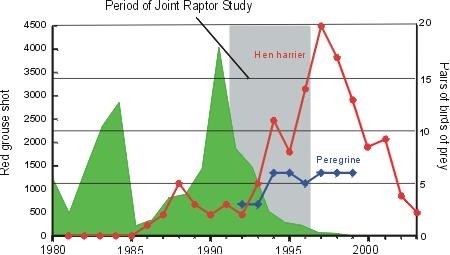A decade of research
 We have studied hen harriers and grouse at Langholm for over a decade, and the Joint Raptor Study (JRS) has challenged scientific thinking on raptor predation. Here we review the findings and implications of Simon Thirgood's collaborative work with Steve Redpath (Centre for Ecology and Hydrology), and studies since.
We have studied hen harriers and grouse at Langholm for over a decade, and the Joint Raptor Study (JRS) has challenged scientific thinking on raptor predation. Here we review the findings and implications of Simon Thirgood's collaborative work with Steve Redpath (Centre for Ecology and Hydrology), and studies since.
When raptors are specially protected on gamekeepered grouse moors, hen harrier numbers seem to be governed by the abundance of their main foods - the meadow pipit and the field vole. At Langholm, harrier numbers peaked at 20 breeding females in 1997; a good vole year. Since voles and pipits prefer grass to heather dominated habitats, moors with a high proportion of grass tend therefore to attract more harriers.
Steve and Simon estimated the number of grouse eaten by raptors at Langholm during 1995 and 1996 when bird of prey numbers were high. In these two years raptors killed around 30% of adult grouse during the winter and a further 30% the following summer. In addition, the hen harriers took about 40% of all of the grouse chicks. Over a 2-year period, August grouse numbers at Langholm would have been about 4 times higher had raptors been absent.
The depletion of grouse stocks at Langholm was so severe that by 1999, the estate abandoned all attempts at shooting, and since then numbers of grouse have dwindled further to about 10 grouse per square kilometre in spring.
It has been claimed that Langholm was likely to be a special case and was not typical of other moors. However, when we looked at meadow pipit abundance on 29 other moors we found that Langholm, in fact, had average numbers of pipits.
One of the moors in the JRS (Moor C) is widely held up as an example where the habitat did give a better 'balance' between grouse and raptors. It had no more than 6 breeding harrier pairs during the study. However, this was not sustained and there were no breeding harriers left by 1997 and grouse shooting was at its lowest for twenty years.
Figure 1: Grouse and raptors at Langholm; before, during, and after the JRS. Numbers of grouse shot (green) and numbers of raptor breeding pairs (red & blue lines) are shown

Currently there seem to be only two legal options open to a grouse moor owner. Alter the habitat so that hen harriers choose not to settle on the moor ie. get rid of the grass which supports the meadow pipits and voles, or provide the hen harriers with something else to eat - a technique termed diversionary feeding.
In 1998 and 1999 Steve Redpath and Simon Thirgood tested diversionary feeding. Over two summers they fed half of the nesting harriers with carrion. This did reduce the number of grouse chicks the harriers brought back to their nests by up to 86%, but it did not improve the survival of grouse overall and grouse production remained low. More trials are clearly needed.
Langholm has also raised some wider conservation issues. First, is a habitat solution is really desirable? An upland mosaic of heather and grass supports a much wider biodiversity of bird life than a contiguous heather sward. It would not be sensible to encourage grouse moor owners to embark on habitat changes that were ultimately bad for biodiversity. Second, is the cost of Specially Protected Areas to conserve harriers really worth it? Langholm was nominated as one of the first of these, but if it cannot sustain the harriers without a substantial increase in funding by the tax payer, surely it would have been better to have devised a strategy to retain a more limited number of harriers compatible with grouse moor management and have it funded by the shooting?